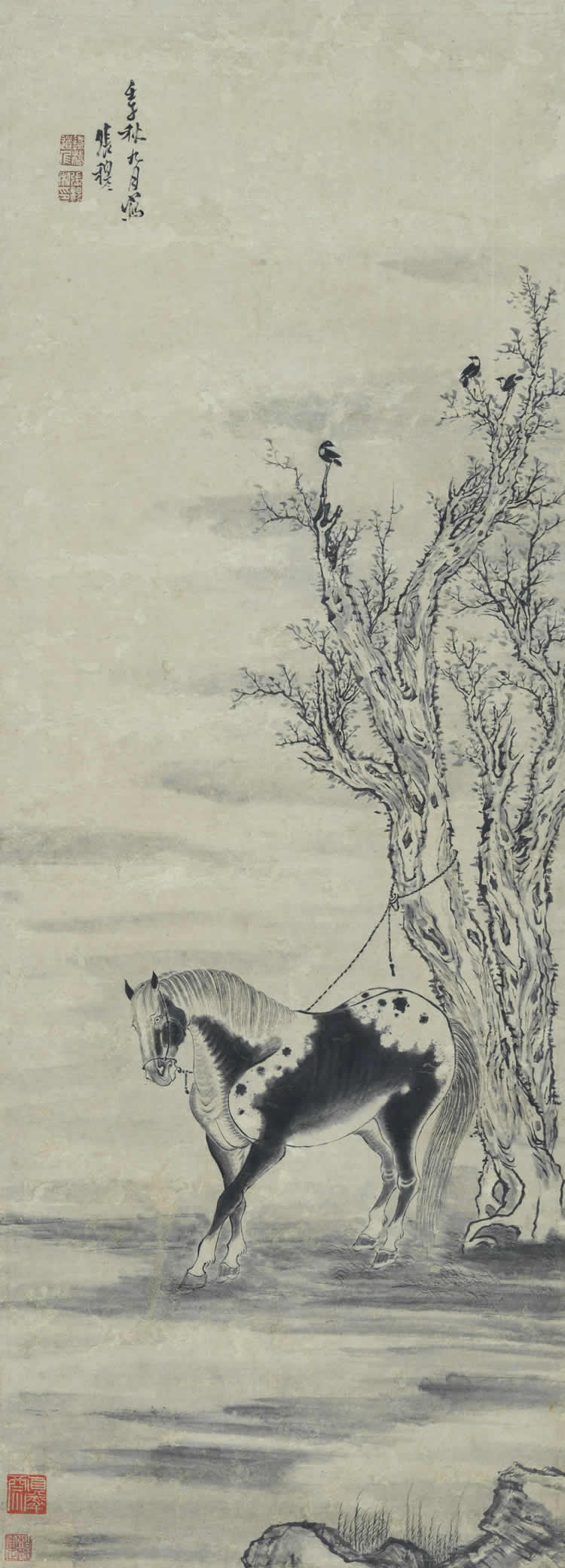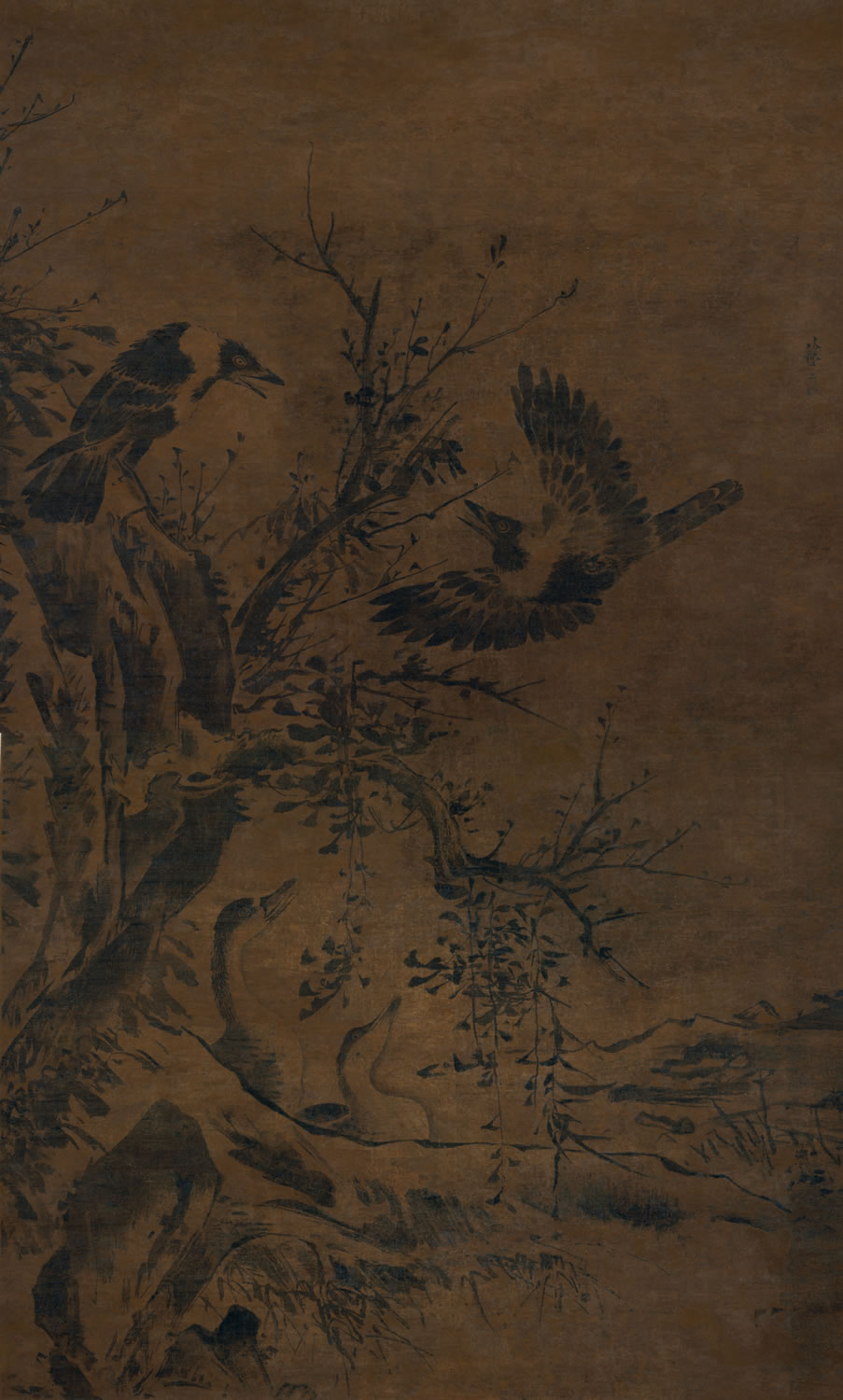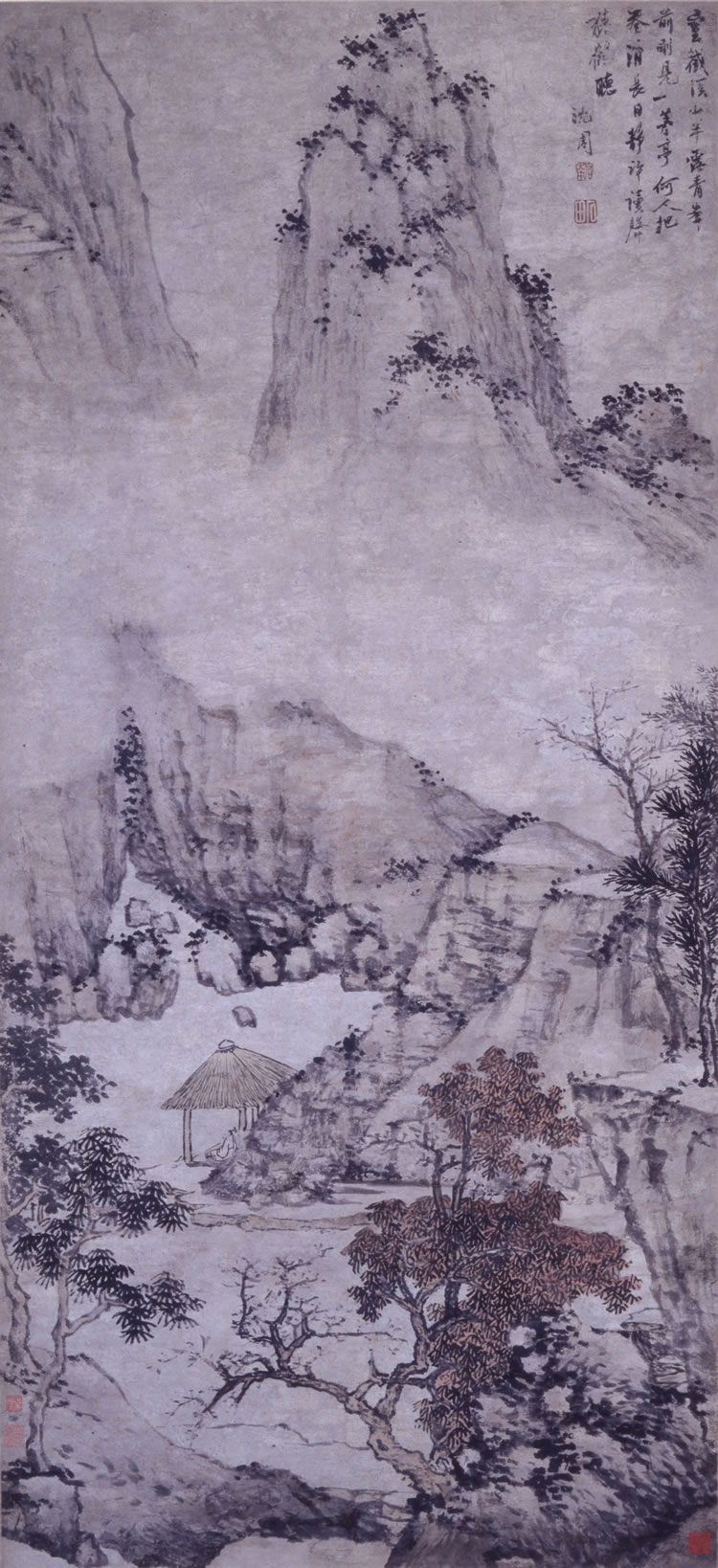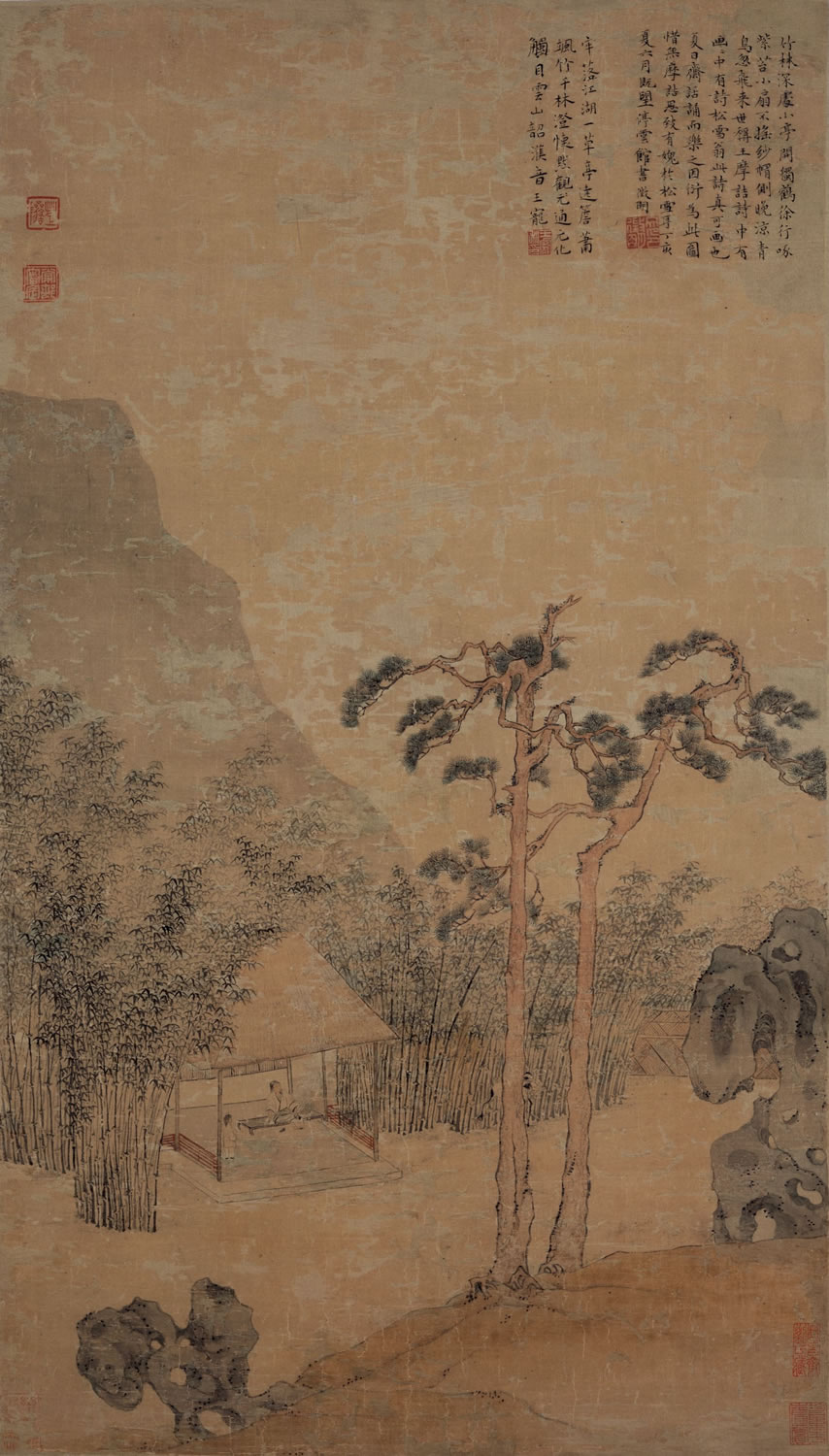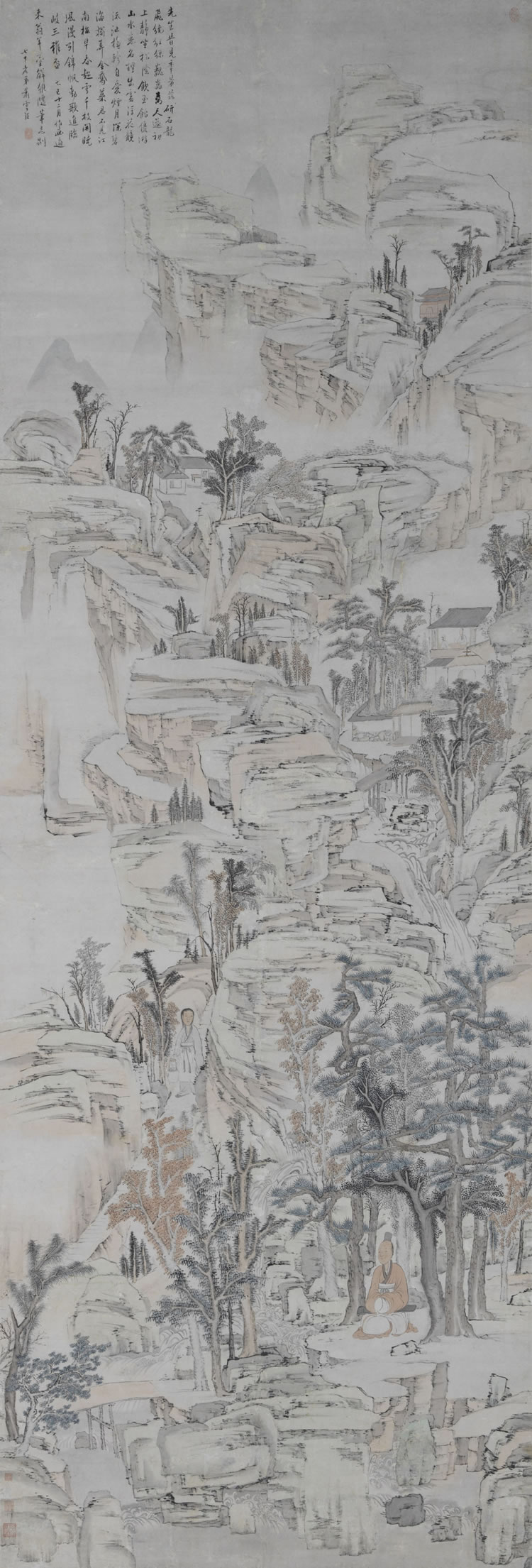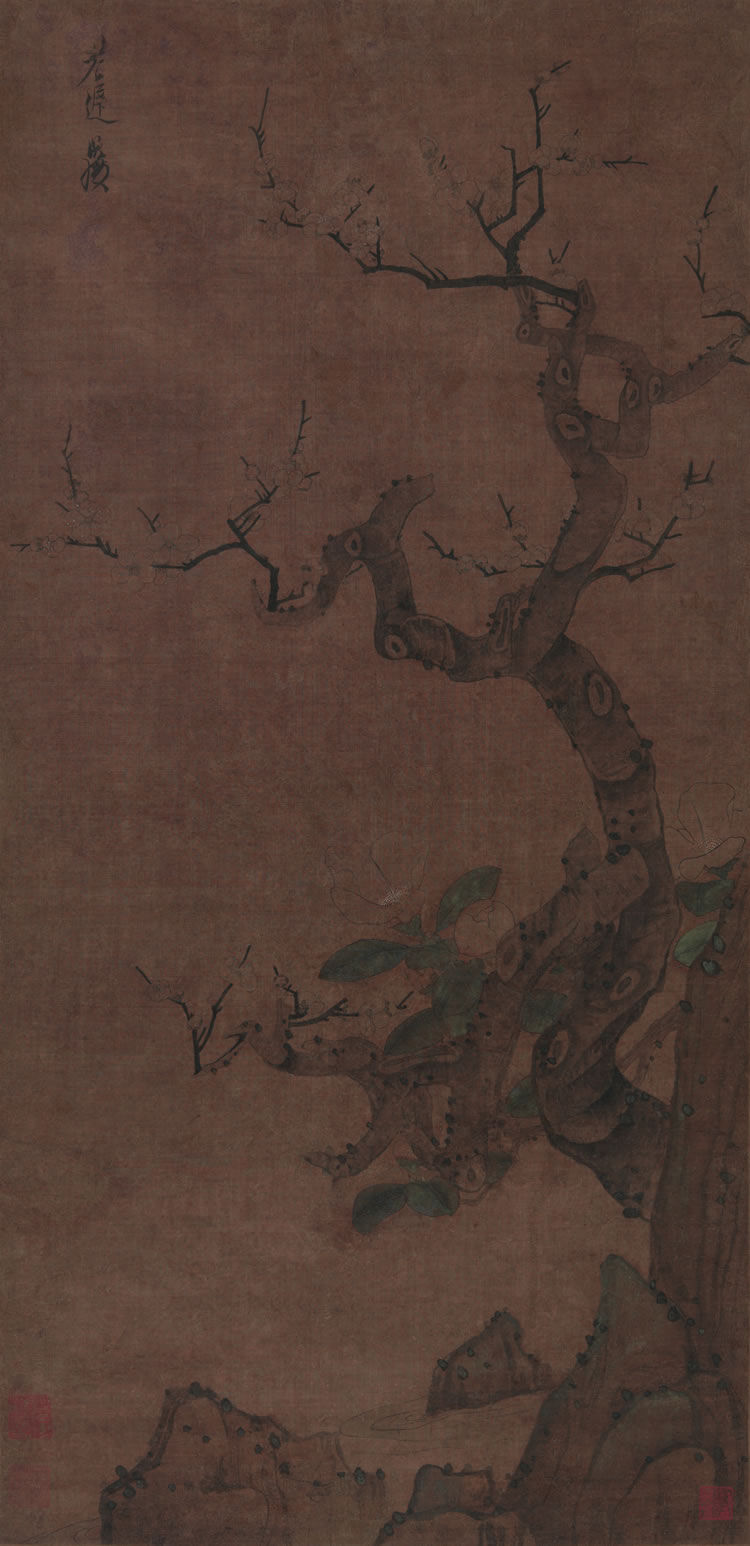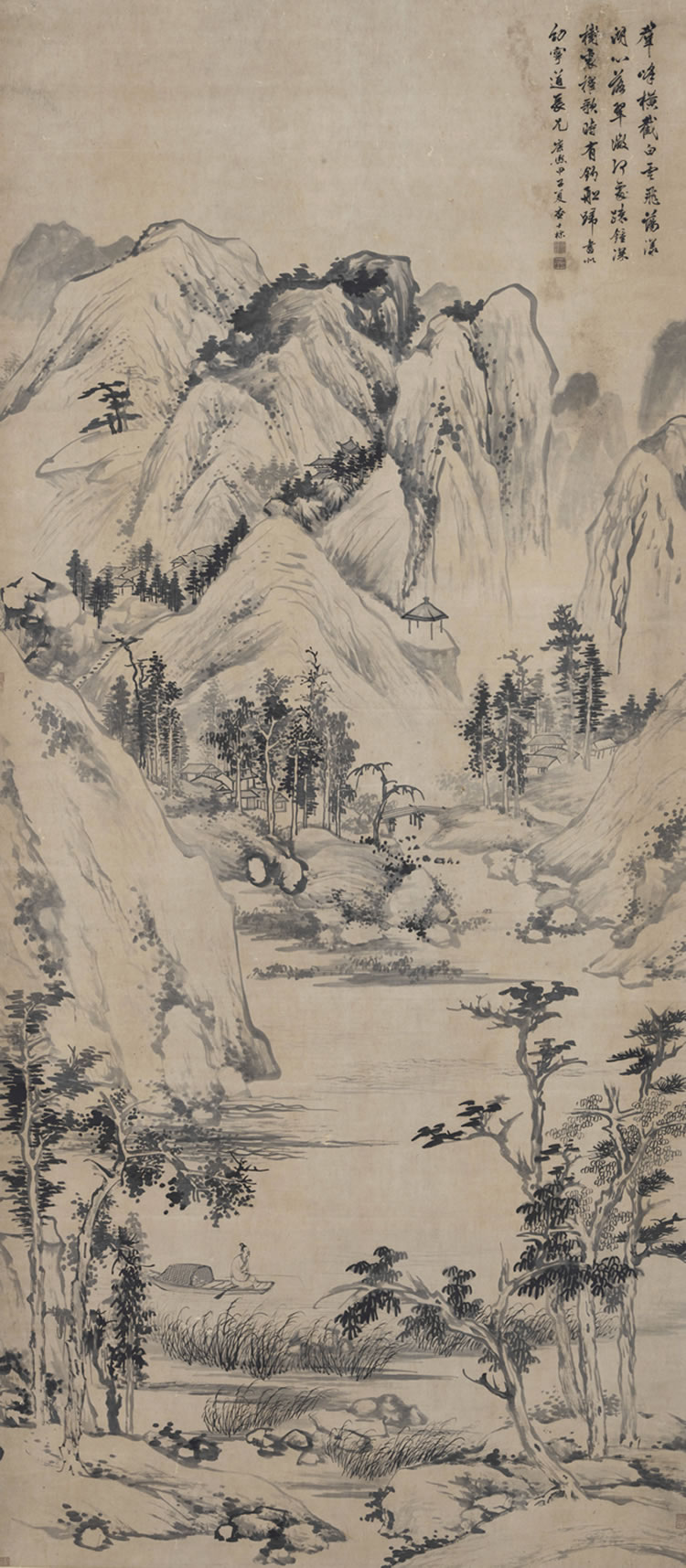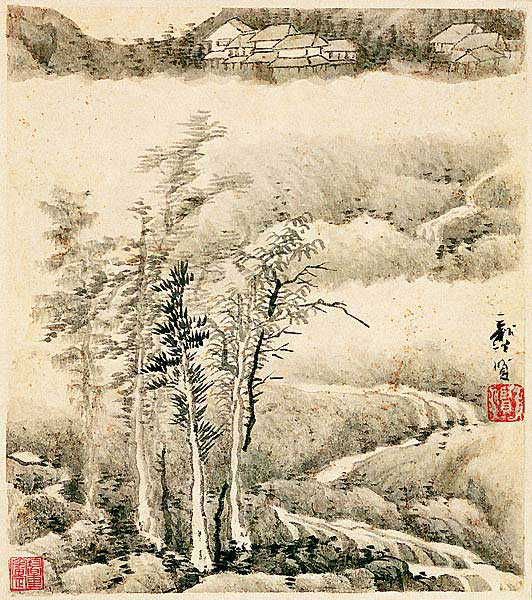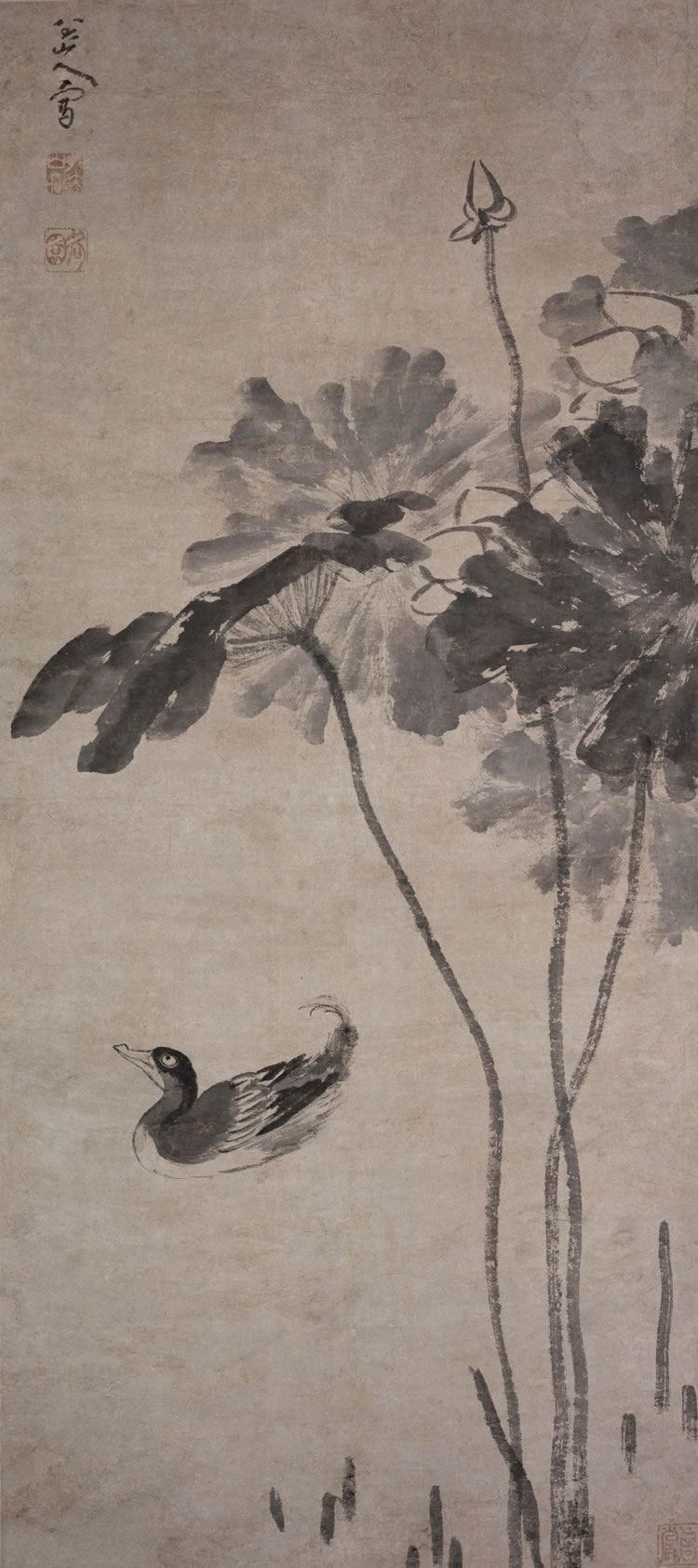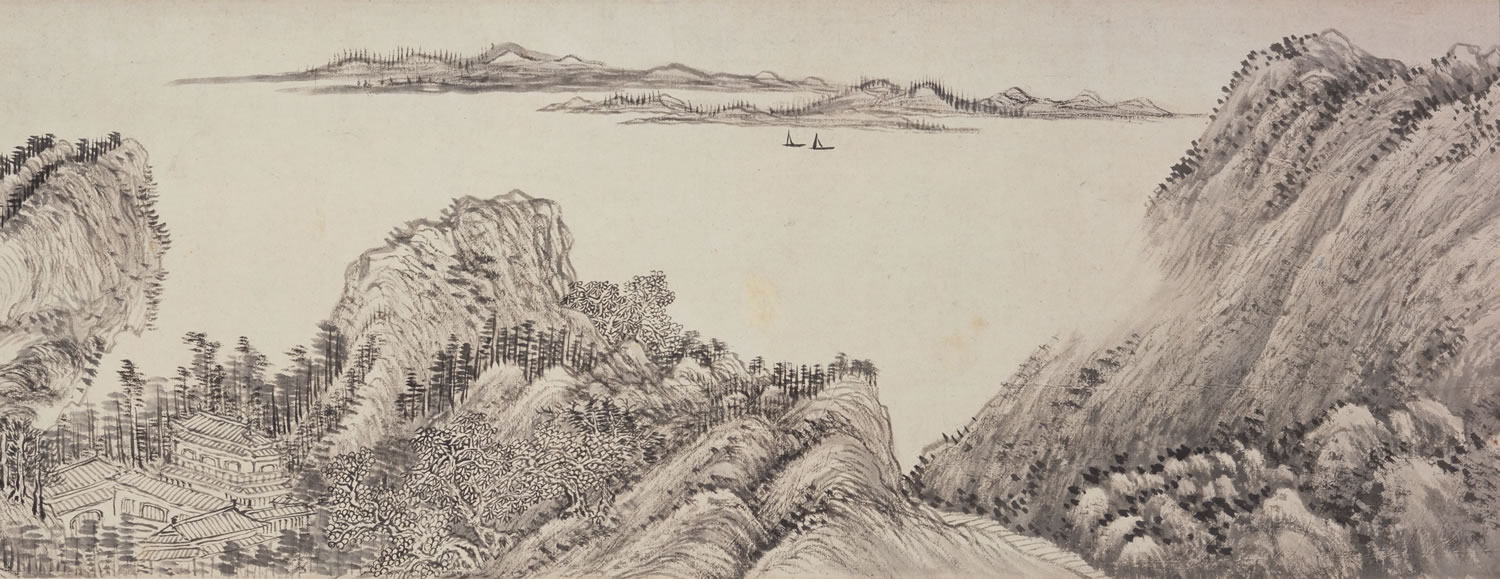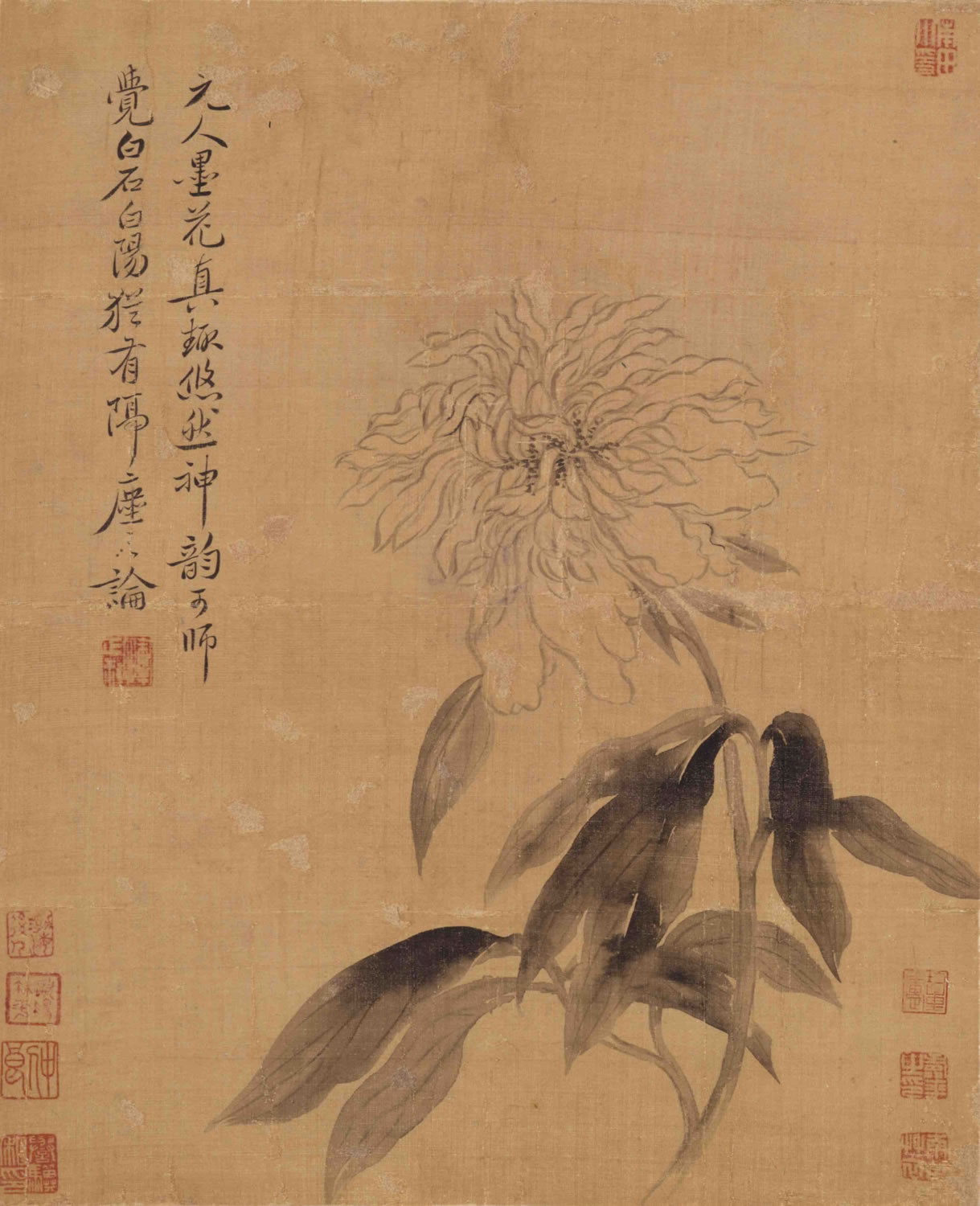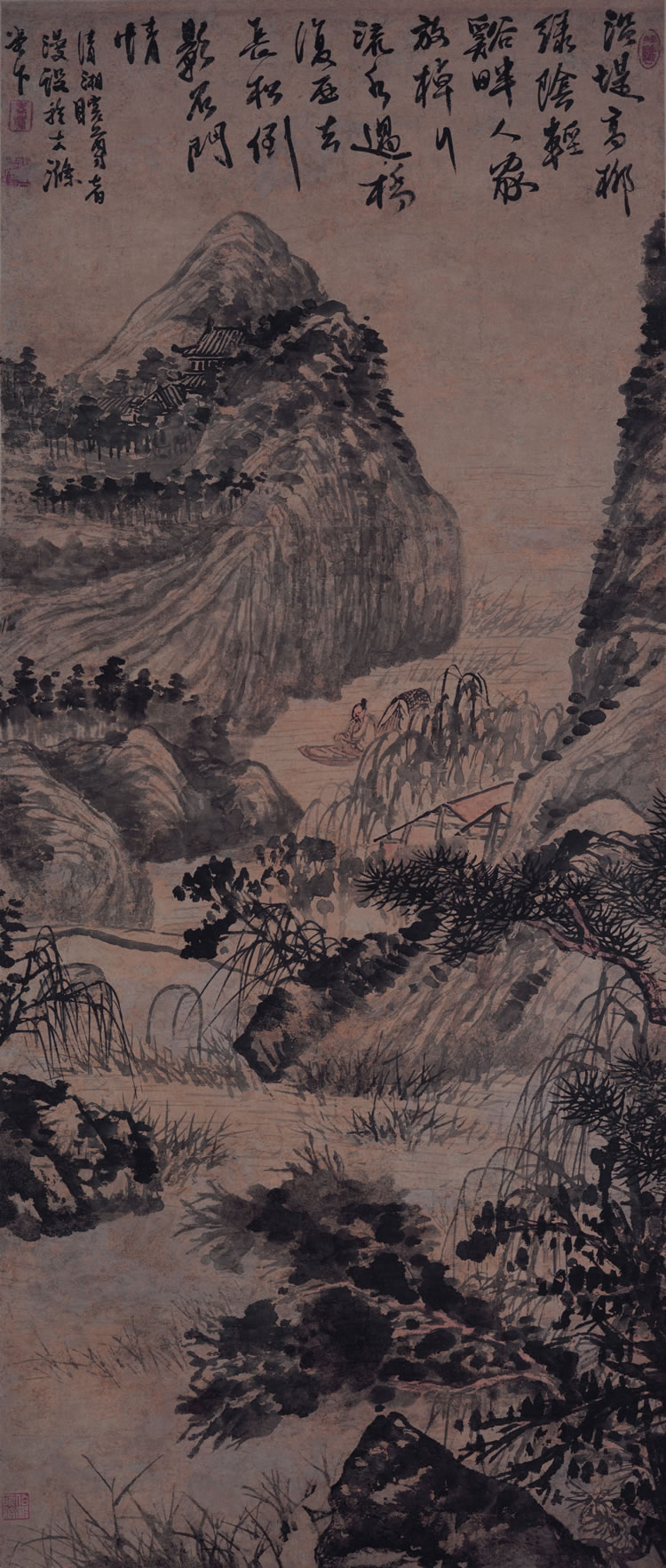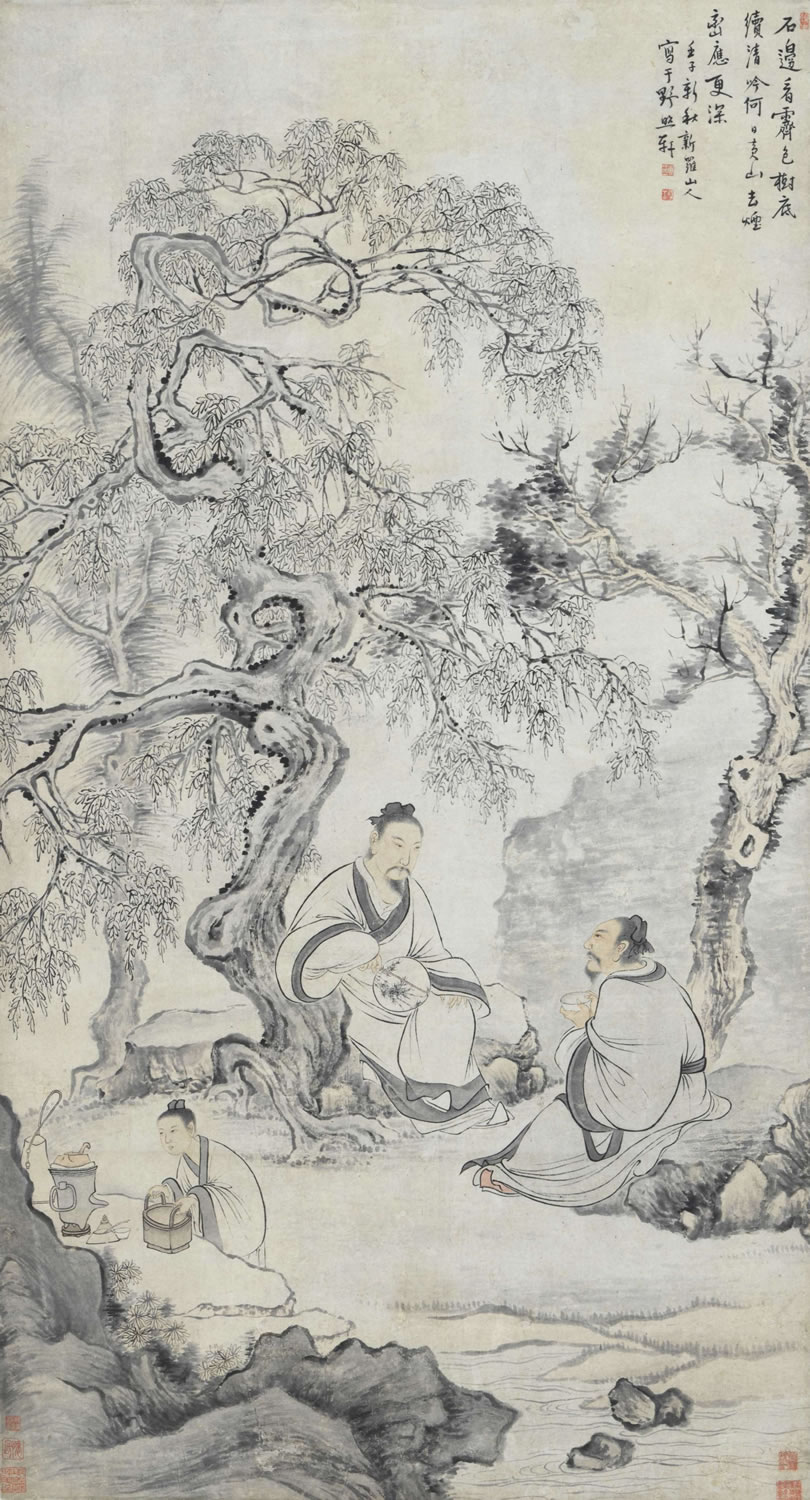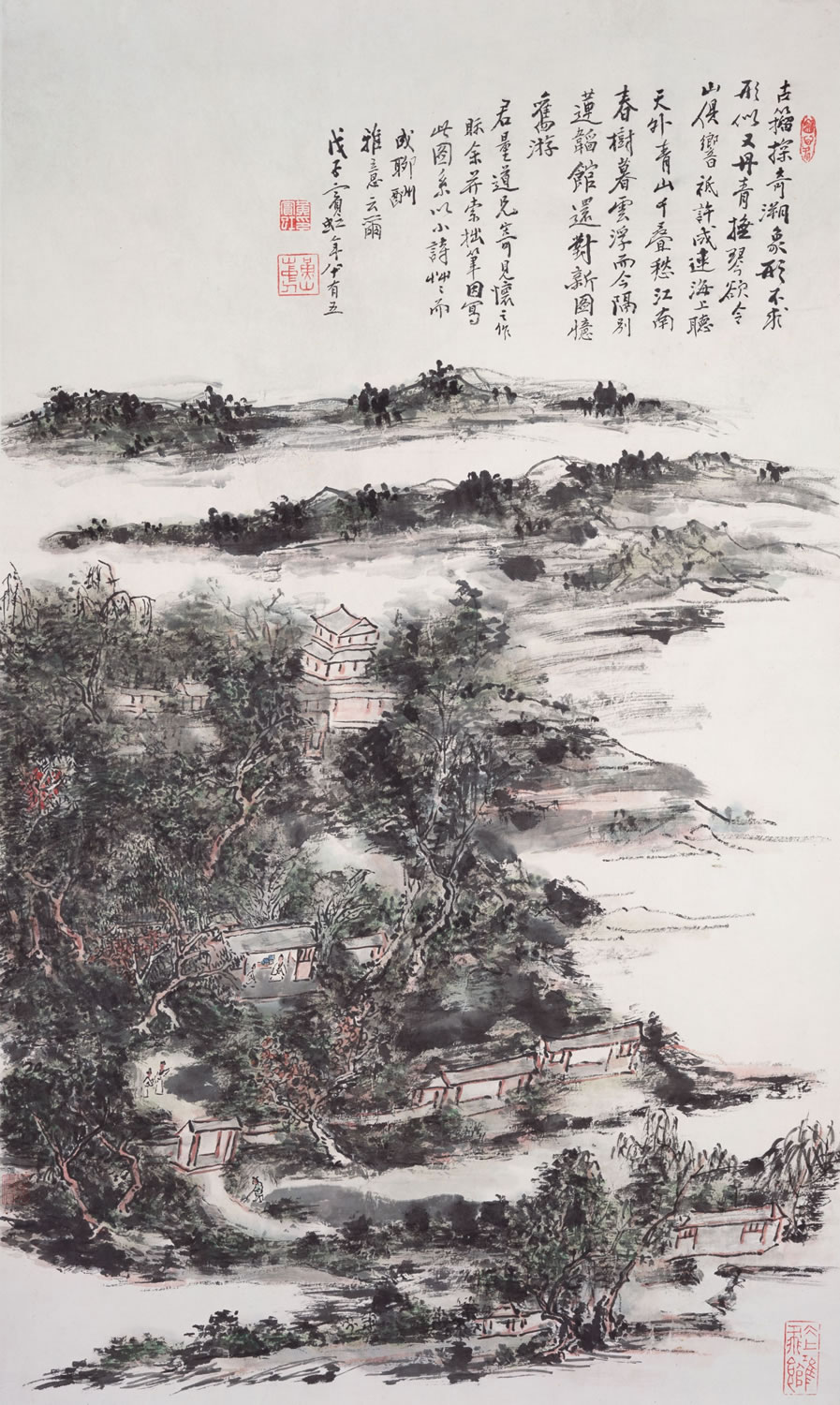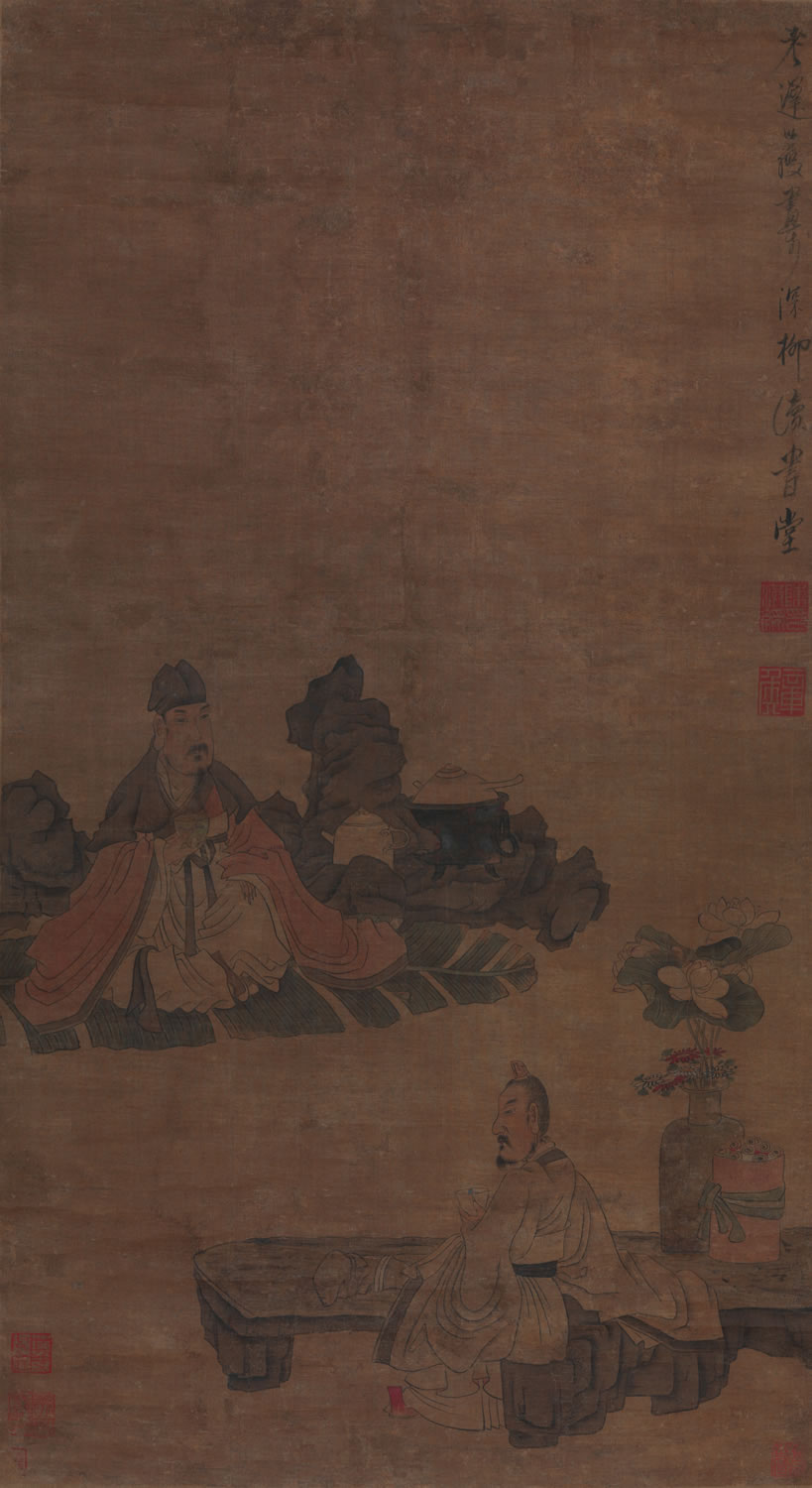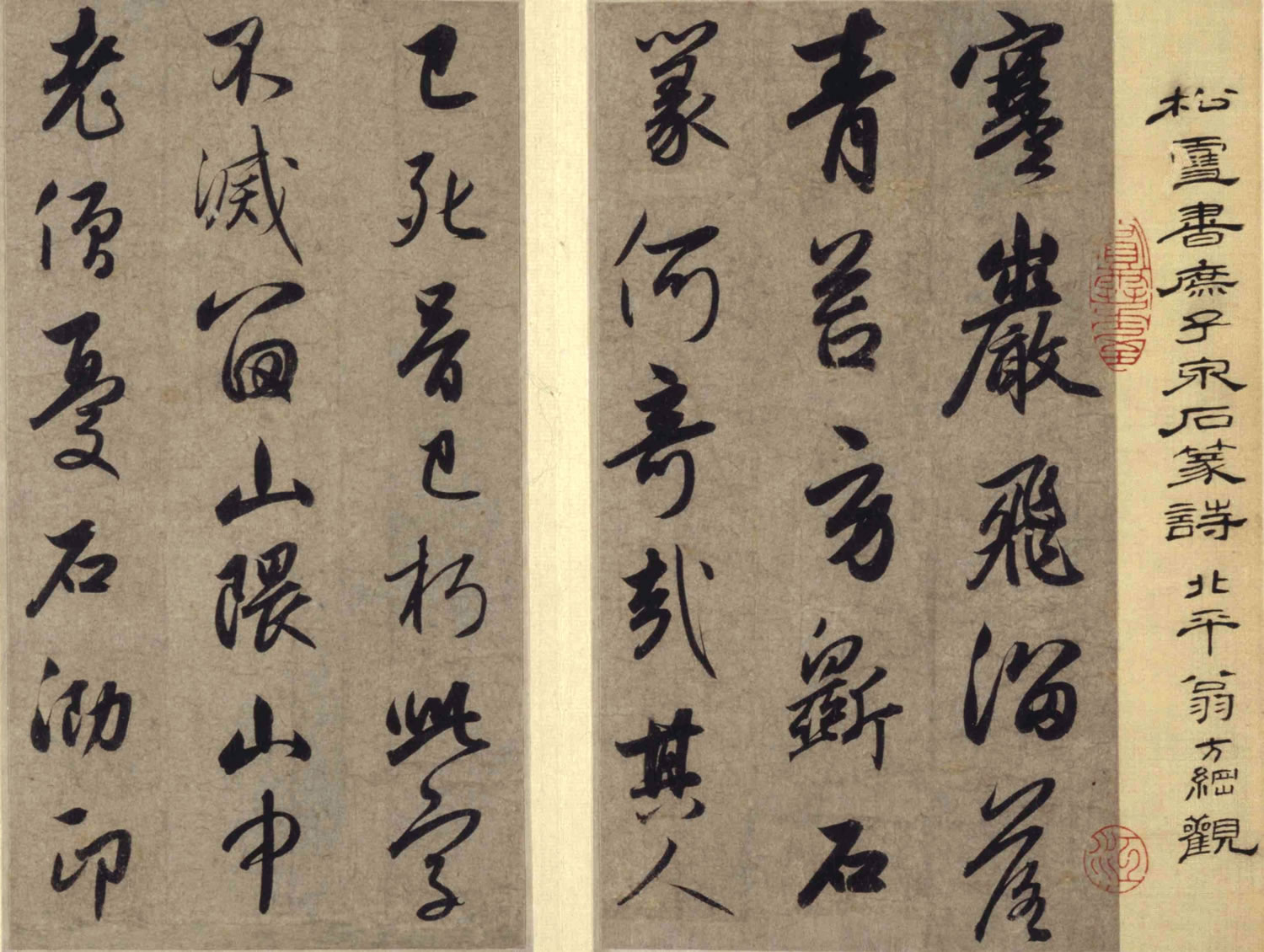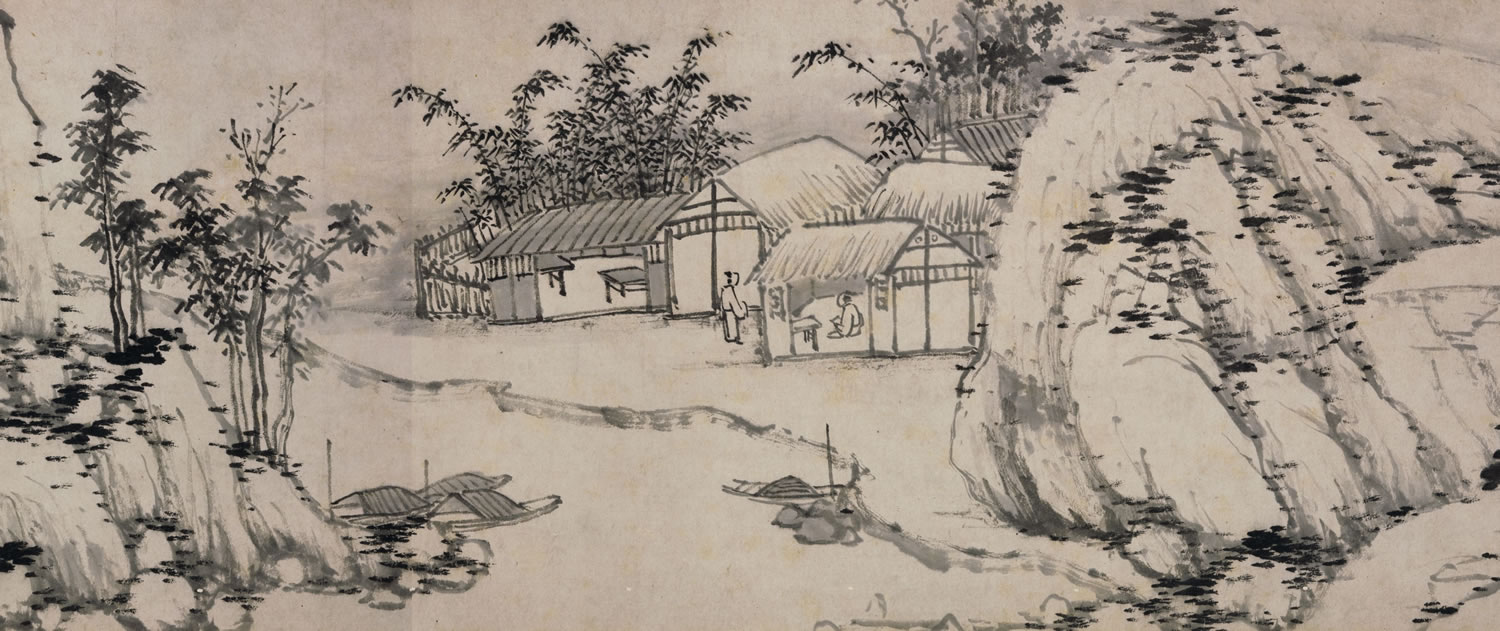 Web Content Display
Web Content Display
Xubaizhai Collection of Chinese Painting and Calligraphy
The Xubaizhai Gallery of Chinese Painting and Calligraphy was built in 1992 to provide a permanent home for the collection donated by renowned art connoisseur Mr Low Chuck-tiew (1911 – 1993).
Mr Low Chuck-tiew's interest in Chinese painting and calligraphy was first inspired by his father, who was himself an avid art collector. Later, as a student at Jinan University in Shanghai, Mr Low took up painting under the instruction of the famous bird-and-flower artist Xie Gongzhan (1885 – 1940) and the celebrated landscape painter Huang Binhong (1865 – 1955), and it was the influence of Huang's connoisseurship in the field of Chinese art that stimulated Mr Low to start his own collection, despite his limited financial resources.
Arriving in Hong Kong after World War II, Mr Low soon came to realise the extent of the exodus of Chinese artworks from China through the territory, which was a thriving marketplace for the trade in Chinese antiquities. Deeply perturbed by the sight of these objects being sold overseas and with a growing anxiety over the dispersal of large swathes of China's cultural heritage, Mr Low was spurred to redouble his efforts to acquire Chinese works of art. He named his collection the Xubaizhai Collection of Chinese Painting and Calligraphy after one of his most treasured items, a calligraphic plaque by Yi Bingshou (1754 – 1815).
The collection primarily encompasses works from the Ming (1368 – 1644) and Qing (1644 – 1911) dynasties through the twentieth century and is particularly rich in masterpieces from the major painting schools, including the “Wu School”, the “Songjiang School”, the “Four Monks”, the "Orthodox School" and the “Eight Eccentrics of Yangzhou”. A fascinating period in the history of Chinese art, the mid to late Ming saw the proliferation of a great diversity of schools and stylistic currents. A new and equally exciting era then emerged during the transition to the Qing, in which orthodoxy and individualism co-existed within the literati tradition: the orthodox followed the tenets elaborated by the Ming artist Dong Qichang (1555 – 1636), while the individualists escaped into a private world of eccentricity, thus helping to create new horizons in painting during the early Qing period.
Mr Low Chuck-tiew donated his collection to the Hong Kong Museum of Art in 1989 in the well-founded hope that it could be both preserved and made available for public display in order to maximise its educational and historical value. The donation represents a valuable enrichment of the museum's own catalogue of Chinese paintings and calligraphic works, significantly expanding its previously rather parochial focus to constitute a comprehensive collection of undoubted quality.
What's more, the donation reflects the growing confidence of the territory's cultural community in our institution. The inauguration of the Xubaizhai Gallery at the Hong Kong Museum of Art is an acknowledgement of the generous gesture of an eminent connoisseur in turning an important private collection into a valuable public one.
-
Avadana-sutra, volume 6 in small regular script
-
Anonymous (Tang dynasty, 618 – 907)
-
Not dated
-
Handscroll (section), ink on paper
-
26.8 x 1489.5 cm
Sutras – collections of dialogues and discourses from classic Mahayana Buddhism – first attracted worldwide attention and academic interest when the Dunhuang Library Cave housing ancient manuscripts, paintings and artefacts was discovered in 1900. Since that time, the dispersal of thousands of the manuscripts among libraries and institutions around the world following a succession of international archaeological expeditions has prompted a new field of research known as "Dunhuang Studies". Although the vast majority of sutra manuscripts have been found at the Library Cave, the practice of transcribing sutras was not limited to Dunhuang, but was carried out at several other sites along the old Silk Road.
The copying of Buddhist sutras and the private patronage of this practice were both considered a form of personal devotion and a way to attain spiritual merit. Handed down over the centuries, this valuable Avadana sutra was previously held in the collections of the imperial family of the Qing dynasty. The sutra is written in a small regular script that is elegant and well balanced and that places the emphasis on even brushstrokes. Known as jingshengshu, this writing style differed from the established calligraphy tradition of that time and called for the use of a shorter and thicker brush. -
-
Jackdaws and wild geese
-
Lin Liang (ca. 1426 – ca. 1495)
-
Not dated
-
Hanging scroll, ink on silk
-
169.5 x 102.5 cm
A native of Guangzhou, Lin Liang entered the court as a painter and was quickly promoted to Commander of the Imperial Bodyguard, the highest rank a court painter could achieve. In his early years, he had studied landscape painting under his fellow villager Yan Zong and figure painting under He Yin. Adept at painting flowers and birds in ink with spontaneous yet forceful and expressive brushstrokes, Lin drew heavily for his technique on the styles of the Southern Song Chan (Zen in Japanese) painters Liang Kai and Muxi. As a bird-and-flower painter, Lin Liang enjoyed equal fame with Lü Ji.
The jackdaws and wild geese in this hanging scroll are portrayed in a natural setting of rock and withered wood. By depicting the energetic and lively movement of the birds with a bold and expressive brushwork, Lin successfully conveys the charming vitality of his subjects. Following the style of the Southern Song Painting Academy, he employs "axe-cut" strokes and the ink wash technique to depict the rock and the wood. -
-
Clouds amid mountains and stream
-
Shen Zhou (1427 – 1509)
-
Not dated
-
Hanging scroll, ink and colour on paper
-
148 x 68.2 cm
Shen Zhou, courtesy name Qinan, also known as Shitian or Baishiweng, was a native of Suzhou in Jiangsu province. A student of Chen Kuan, Du Qiong and Liu Jue, he modelled his paintings on the styles of Wang Fu and the Four Masters of the Yuan dynasty, but also extended his interest to the works of the Zhe School. In his younger days, he painted small-format works with restrained and tightly woven brushstrokes, a style that became known as "fine Shen". But after reaching the age of forty, he adopted large formats and painted in a bold and expressive manner, which was then termed "rough Shen". Having inherited the mogu (boneless) method of bird-and-flower painting from Qian Xuan, he opened up a new horizon in literati painting style and went on to teach Wen Zhengming and Tang Yin. Shen, his two students and Qiu Ying became known as the Four Masters of the Ming dynasty.
This work belongs to the "rough Shen" style where the brushstrokes are executed in a bold and unrestrained manner. Left blank to represent the clouds and mist, the void halfway up the mountains not only moderates the dense composition of the painting but also adds a more towering effect to the lofty mountains. -
-
Poem on Encountering Sorrow in running script
-
Zhu Yunming (1461 – 1527)
-
1496
-
Handscroll (section), ink on paper
-
29.5 x 582.7 cm
A native of Suzhou in Jiangsu province who served as an official in Guangdong province and Nanjing, Zhu Yunming, also called Zhishan, was one of the Four Gifted Scholars of the Wu district. Assiduously studying and copying the calligraphy of the Wei and Jin masters in his middle age, he inherited his small regular script from the neat and disciplined brushwork of Zhong Yao and Wang Xizhi, while his running script incorporated the stylistic features of the Jin masters. For his cursive script, however, he adopted the forceful, unrestrained styles of Huaisu and Huang Tingjian. Zhu is regarded as one of the most prominent calligraphers of the mid Ming period.
This work is one of Zhu Yunming's early works. Qu Yuan, a poet of high moral standing in the Warring States period, wrote the original poem, which became a famous model and theme for calligraphers, painters and the literati through the dynasties. In Zhu's work, the neat and graceful running script differs sharply from his imposing cursive script, while his elegant brush also reveals the influence of the early masters Zhong Yao and Wang Xizhi. This handscroll was formerly held in the imperial collections of the Qing dynasty. -
-
In the deep shade of a bamboo grove
-
Wen Zhengming (1470 – 1559)
-
1527
-
Hanging scroll, ink and colour on silk
-
71.5 x 41 cm
Wen Zhengming, original name Wen Bi, also called Hengshan, he received direct tutelage from Shen Zhou but also paid particular attention to the styles of Zhao Mengfu, Wang Meng and Wu Zhen. His landscape paintings exhibit two different modes, one bold and expressive, and the other meticulous and restrained, while his figure painting assimilated the plain-outlining technique of Li Gonglin, and in his bird-and-flower painting he adopted the spontaneous style of the Yuan painters. He modelled his calligraphy on the styles of Huang Tingjian and Zhao Mengfu and excelled in writing small regular script. One of the Four Gifted Scholars of the Wu district and of the Four Masters of the Ming dynasty, Wen had many descendants and students to perpetuate his tradition, and he thus exerted a profound and far-reaching influence on the history of Chinese painting.
This painting depicts a scholar taking a rest in the summer breeze. The crane, the bamboo, the junipers and the rock are impregnated with literati symbolism, while the composition of the painting relates poetically to aesthetic theories. In the inscription that accompanies the painting, Wen describes how he learned the blue-and-green painting style from Zhao Mengfu and pays tribute to this master as well as to Wang Wei. -
-
Song on the Spring of Luoyang in running script after Mi Fu
-
Dong Qichang (1555 – 1636)
-
Not dated
-
Handscroll (section), ink on paper
-
41 x 461 cm
A native of Songjiang who later attained the post of Minister of Rites, Dong Qichang, courtesy name Xuanzai, also called Sibai, enjoyed wide acclaim among his contemporaries, while his theory on the "Northern and Southern Schools of Painting" exerted a tremendous influence on subsequent generations. Assimilating the styles of various masters, he specialised in regular, running and cursive scripts, and his calligraphy was a great favourite of Emperor Kangxi. He is hailed as one of the most influential calligraphers of the Ming and Qing dynasties.
The handscroll format is well suited to Dong's calligraphic execution. This work, which demonstrates his mastery of brush techniques, is a creative copy after Mi Fu, one of the Four Song Masters in calligraphy. Mi Fu's art obviously represented an ideal model for Dong's artistic pursuit, as a great deal of his calligraphy works and paintings were executed in the style of this master. Although Dong mentioned in the inscription that this handscroll was done in the style of Mi Fu, his interest laid not in recreating any similarity of form but in capturing the spirit of the ancient master's calligraphy. Dong created his unique style by producing a rhythmic movement in the overall pattern of the work, which is evoked through the subtle change of black and grey ink as well as the variations between thick and fine brushstrokes. -
-
Poem on Yinyi Lou in running script
-
Wang Duo (1592 – 1652)
-
1631
-
Hanging scroll, ink on silk
-
286 x 73 cm
Wang Duo, courtesy name Juesi, was from Mengjin in Henan province and held official post as high-ranking as Secretary in the Rites and Education Ministry. His landscapes are reminiscent of Jing Hao and Guan Tong of ancient times. He did not give much texture to his rocks and his colouring was light. He occasionally painted flowers and rocks. His calligraphic style was derived from ancient masters, such as Zhong Yao, Yan Zhenqing, Mi Fu, Wang Xizhi and Wang Xianzhi, but had its own individuality nonetheless. He was particularly skilful at the running script and cursive script, and established a style of his own which was quite independent of those of Zhao Mengfu and Dong Qichang, which were the most popular styles at the time.
This work has vigour in addition to the unusual and varied forms, with the use of dry and wet brushstrokes, resulting in variation in ink tones. The close links between one character and another, and the distribution of spaces within the characters, all speak for his well-practised skills. Each column is united into a coherent whole by the continuous flow and liveliness of the strokes. Combining his powerful strokes with frequent variation in ink tones, Wang Duo brought the cursive script to a new height during the late Ming and the early Qing periods. -
-
Playing the lute under pine trees
-
Xiao Yuncong (1596 – 1673)
-
1666
-
Hanging scroll, ink and colour on paper
-
304.5 x 103.5 cm
Xiao Yuncong, courtesy name Chimu, enjoyed a considerable reputation for his poetry and calligraphy, but it was as a painter, where he followed Ni Zan and Huang Gongwang, that this native of Wuhu in Anhui province excelled. His landscape paintings were executed with dry brush slashes that shaped an angular and delineated configuration, and his style exerted a profound influence on artists in the district of Wuhu who later formed the Gushu School of Painting. He also had a connection with Hongren, on whom he also seemed to have had an impact judging by the stylistic similarities that they shared.
This painting is a monumental execution of a vocabulary basically derived from Ni Zan. Using the cebi (side brush), rocks are delineated block by block and stacked up into a mountainous terrain that is elevated to a great height on a distinctly tilted plane. The linearity of stark lines typically used by Ni Zan to depict a Jiangnan water scene is here transposed to render a mountain landscape. The ancient master's stock motifs — the rustic pavilion by sparse trees, the stretch of water and distant rolling hills — are subsumed in a densely packed composition, as Xiao Yuncong's unique manipulation of the Ni Zan idiom further develops the austere style of this genre. -
-
Camellia, plum blossoms and rock
-
Chen Hongshou (1598 – 1652)
-
Not dated
-
Hanging scroll, ink and colour on silk
-
94.5 x 46 cm
A native of Zhuji in Zhejiang province who was at one time a monk and who in his later years earned his living as a professional painter in Hangzhou and Shaoxing, Chen Hongshou, style name Zhanghou, alias Laolian, received direct tutelage in painting from Lan Ying and emulated Xu Wei's style. His figure paintings are characterised by exaggerated and archaistic forms, while the forms and colours of his landscapes and bird-and-flower paintings are also rich in decorative flavours. Chen exerted a great influence on later generations such as the Eight Eccentrics of Yangzhou, Ren Xiong, Ren Yi and others.
The fine, smooth and even brush lines in this painting are characteristic of Chen's late style. Demonstrating his sophisticated execution of lines by marking out the plum blossoms and camellia in a meticulous and elegant manner, Chen also deliberately scatters moss dots over the tree and rock as decorative elements to accentuate the images of his subjects. The distorted structure of the trunk and branches, twisting exaggeratedly, is a distinctive feature in works by Chen's contemporaries. -
-
Landscape
-
Hongren (1610 – 1664)
-
Not dated
-
Hanging scroll, ink and colour on paper
-
187 x 78 cm
Hongren, also known as Jianjiang Xueren, a native of Shexian, Anhui province, became a monk at Mount Wuyi to avoid association with the Manchu rulers after the fall of the Ming and later, after travelling extensively across the nation, he took up residence at Mount Huang. He first followed the painting styles of the Song masters, then adopted the styles of the Four Masters of the Yuan dynasty and pursued a profound interest in the style of Ni Zan. His landscapes of the scenery of Mount Huang are characterised by a geometrically delineated composition as well as dry and angular brush lines. One of the Four Monks, he is also regarded as an important figure of the Huangshan School and the Xin'an School.
This painting makes stylistic allusion to Ni Zan in an exaggerated and formalised manner. The river landscape so often found in Ni's works is transformed into rocks and cliffs in a rectilinear formation of overlapping planes. In the foreground, low slopes drawn with "hemp-fibre texture strokes" lead to a stream flowing to the right. The tree directs the eyes to the complex of high bluffs with receding flat tops that rises to dominate the composition. To indicate this height, a house is set in a clearing at the back of the rocky promontory, and the entire composition is thus filled by tightly interlocking shapes and textures. -
-
Fisherman returning home
-
Zha Shibiao (1615 – 1698)
-
1684
-
Hanging scroll, ink on paper
-
284 x 125 cm
A native of Anhui province, Zha Shibiao, courtesy name Erzhan, also called Meihe, refused to take up any official post after the fall of the Ming dynasty, eventually settling in Yangzhou in his later years. He followed the calligraphy styles of Dong Qichang and Mi Fu, while his landscapes in the style of Ni Zan are suggestive of a wintry desolation also reminiscent of Hongren. His later brushwork, having assimilated the styles of Wu Zhen and Dong Qichang, became wetter and more expressive in contrast to Hongren's sparse, dry landscapes. Zha was famed as one of the Four Masters of Xin'an. -
-
Landscapes
-
Gong Xian (1619 – 1689)
-
Not dated
-
Album of two leaves (leaf no. 2), ink on paper
-
Each ca. 20.2 x 18.3 cm
Gong Xian, courtesy name Banqian, was a native of Jiangsu province who, in the late Ming, retreated to Nanjing where he earned his living by selling paintings and teaching. Attaining fame as the leading figure of the Eight Masters of the Jinling School, he further developed the jimo (ink piling) technique of the Song dynasty and painted landscapes with layers of dense yet translucent brushstrokes. His use of soft, mottled ink dots gives his paintings a chiaroscuro effect and a sense of vigorous substantiality.
Following his early studies under Dong Qichang, Gong Xian was able to develop his own personal style and he is acclaimed as one of the most important individualist painters of the early Qing period. The contrast of light and dark and the moist-looking ink dots and texture in this album leaf are characteristic of the mature style of his late period. The tall trees depicted with differently delineated foliage are juxtaposed as the focus of the picture, while at the lower right a meandering stream leads the way back to the distant ravines. The composition is confined at the top by the expanse of mist as well as the cottages nestling among the horizontal cliffs, and this arrangement of the background provides a dramatic contrast to the verticality of the trees to convey a sense of nature's durability. -
-
Lotus and mallard
-
Zhu Da (1626 – 1705)
-
Not dated
-
Hanging scroll, ink on paper
-
117 x 52.5 cm
Zhu Da, also known as Bada Shanren, went under many pseudonyms. A descendant of the Ming imperial family, he fled to become a monk after the fall of the dynasty and was later known as one of the Four Monks. His paintings, in particular those that take a bird-and-flower subject, are rich in symbolic meaning which he used as a vehicle to express his inner emotions. Initially modelling his landscapes on Dong Qichang, he later incorporated the styles of Huang Gongwang and Ni Zan.
This bird-and-flower painting, characterised by simplified and abstract forms but vigorous and expressive brushwork, is derived from the styles of the Ming masters Lin Liang, Chen Chun and Xu Wei. The lotus leaves are painted in the xieyi style where the brushwork is free and unrestrained, but the eccentric manner of portrayal — the desolate image of the mallard with its queer eye staring upwards produces an enigmatic and disquieting emotion — was seldom practised in this genre by his contemporaries. What's more, the large blank area representing the pond creates and maintains the stability of the whole composition, leaving room for the viewer's imagination to run free. -
-
A dream journey to the mountains and rivers
-
Wang Hui (1632 – 1717)
-
1702
-
Handscroll (section), ink on paper
-
24.2 x 379 cm
Born to a literati family in Jiangsu province, Wang Hui, courtesy name Shigu, also known as Gengyan Sanren or Qinghui Zhuren, started to paint landscapes in the style of Huang Gongwang in his early years, but his painting skills improved immeasurably under the direct tutelage of Wang Jian and Wang Shimin. These two masters and their student Wang Hui, together with Wang Yuanqi, are collectively known as the Four Wangs, with Wang Hui later becoming one of the leading masters of the Orthodox School.
Wang Hui was summoned by the emperor Kangxi to the capital in 1691 to supervise the production of a series of handscrolls intended to record the imperial tour of inspection to southern China, and this handscroll was completed following his return from the capital. Wang had once proclaimed that perfection in painting could be achieved by employing the techniques of ancient artists, in particular the Song and Yuan masters, and the inscription here suggests that this scroll was executed in the styles of the Song master Juran and the Yuan artist Wang Meng. The mist swirling across the mountain slope and the alum stones on the hilltops are elements derived from Juran, while the curling "ox-hair" brushstrokes that model the rocks and hills are a hallmark of Wang Meng. On the other hand, the "hemp-fibre texture strokes", the rows of small trees on the mountain ridges and the composition of the landscape are reminiscent of another great Yuan master Huang Gongwang, and, in combining the different styles of these old masters, the painting serves to exemplify Wang Hui's skilful eclecticism. -
-
Flower and fruit
-
Yun Shouping (1633 – 1690)
-
Not dated
-
Album of two leaves (leaf no. 1), ink or ink and colour on silk
-
Each ca. 31.5 x 25.5 cm
Though born to a prominent family in Jiangsu province, Yun Shouping, original name Ge, also called Nantian, abstained from entering the civil service in his early years and instead devoted himself to painting, travelling extensively and becoming acquainted with the artists Wang Hui and Zha Shibiao. He switched to bird-and-flower paintings in his middle age, when he adopted Xu Xi's mogu (boneless) method. Emphasising painting from life in order to capture the inner spirit of the subject, he was regarded as the most eminent flower-and-bird painter and one of the Six Masters of the Qing dynasty.
Yun frequently sought stimulation from the past, as can be seen in this album leaf: according to the inscription, the ink peony was inspired by the lofty style of the Yuan masters, a tradition that was continued by the Ming artists Shen Zhou and Chen Chun. Yun employed the "boneless" technique without form-defining outlines, a method that originated with the eleventh century master Xu Xi. The leaves and stem are dabbed with diluted ink wash, while the flower, depicted in sketchy strokes, expresses the upright mood of the peony, a unique trait of the artist. By imbuing fresh life and beauty into the genre of flower painting, Yun's art represented a new mode in the more spontaneous style that attracted a popular following throughout the Qing dynasty. -
-
Boating on a willow stream
-
Shitao (1642 – 1707)
-
Not dated
-
Hanging scroll, ink and colour on paper
-
127.5 x 54 cm
Shitao, original name Zhu Ruoji, is known by many other names, including Dadizi and Kugua Heshang. A descendant of the Ming imperial family, he fled to become a monk after the fall of the dynasty and was thus later known as one of the Four Monks. During his sojourn in Anhui province, he befriended Mei Qing, who had a great impact on Shitao's early landscapes, and it was during this time that he became adept at painting Mount Huang. Settling in Yangzhou in his later years, he became a close friend of another of the Four Monks, Zhu Da, and his works exerted a significant influence on the Yangzhou School of Painting. Shitao attained a wonderful versatility in his paintings, which are characterised by vigorous and powerful images with an extraordinary degree of individuality.
This hanging scroll is primarily painted using wet ink to depict a scene of a stream with willows along its banks. Ink dots of various tones are scattered in size and location, an effect that creates a moist and misty atmosphere that is typical of Shitao's style. Like many of his other paintings, this work suggests the forthrightness of Shitao's character that finds expression in his vigorous and bold brushwork. -
-
Two scholars versifying
-
Hua Yan (1682 – 1756)
-
1732
-
Hanging scroll, ink and colour on paper
-
176.5 x 96 cm
Born to an impoverished family in Fujian province, Hua Yan, also known as Xinluo Shanren, settled in Yangzhou, where he earned his living as a professional painter and a reputation as one of the Eight Eccentrics of Yangzhou. Fond of drawing on the heritage of the old masters, his early figure paintings were influenced by the style of Chen Hongshou, but his style changed when he turned to painting as a professional career.
This painting of two scholars versifying and drinking tea in the shade of a tree demonstrates Hua's sophisticated style. The figures of the scholars and the servant are painted with smooth lines reminiscent of the style of Chen Hongshou. In depicting the scholars versifying, Hua not only portrays the physical appearance of the figures but also captures their lofty spirit; because of their important status, the two scholars are depicted larger than the servant, even though he occupies a more prominent position in the painting. The rock in the foreground is painted using the lanyemiao method (orchid leaf stroke) derived from Ma Hezhi's style. By painting the trees with different foliage in a verdant environment, Hua created a lyrical atmosphere ideal for the presentation of versifying scholars. -
-
Three fruits
-
Emperor Qianlong (1711 – 1799)
-
1760
-
Handscroll, ink on paper
-
25.4 x 82.7 cm
Emperor Qianlong, original name Aixinjueluo Hongli, also known as Gaozong, reigned in China for sixty years. More than 2,500 paintings and calligraphic works and 43,000 poems had been attributed to Qianlong, and he was regarded not only as a prolific painter and calligrapher but also an enthusiastic writer and poet. He was proud of his connoisseurship and had a very strong passion for authentication, inscribing and impressing his collector's seals on the works of the imperial collection. Court painting reached its zenith during the reign of Qianlong in the Qing dynasty, as the court academy produced a large quantity of works serving in large measure as visual records of glorious events as well as for the personal pleasure and enjoyment of the emperor.
Although the ink plant is the most frequent subject in Qianlong's works, the formalised juxtaposition of the fruit and the feeble brushwork of this painting demonstrate that he was not highly competent in this art. The painting also bears his own dazzling seals impressed in prominent positions. The fluid movement with a subtle balance of brushstrokes in his calligraphy reflect the influence of his favourite Yuan artist, Zhao Mengfu, whose calligraphic style was prevalent in court circles during the Qianlong period. -
-
Spring trees in Jiangnan
-
Huang Binhong (1865 – 1955)
-
1948
-
Hanging scroll, ink and colour on paper
-
94.8 x 57 cm
A native of Shexian in Anhui province, Huang Binhong, original name Zhi, courtesy name Pucun, took up editorial duties at several publications and held a number of teaching posts in universities and colleges. An indefatigable traveller and observer of nature, he brought to his landscapes an incomparable familiarity with the natural world. His style reflects in particular the influence of Shiqi and Shitao: his brushwork is at once massive and intricate, and he also reveals a predilection for dark ink tones and for intermingling dry and wet brushstrokes.
This hanging scroll, executed in 1948, was dedicated to Mr Low Chuck-tiew, the donor of the Xubaizhai Collection. Low was a student under Huang and it was thanks to his tutor's guidance that he began to devote his efforts to collecting. The inscription on the painting mentions the Liantaoguan, a studio on the campus of Jinan University where Low took painting lessons. Huang executed the painting in his eighties, the period that is considered to be the most creative and distinctive in the development of his artistic career. Using dots and lines as the principal visual elements of his expressive vocabulary, he creates a rhythmic and vivid movement that goes beyond the superficial resemblance of the subjects depicted. Huang's outstanding accomplishment in the innovation of this tradition opened up a new direction in the genre of expressionistic landscape painting. -
-
Tasting tea
-
Chen Hongshou (1598 – 1652)
-
Not dated
-
Hanging scroll, ink and colour on silk
-
86 x 47 cm
Chen Hongshou, style name Zhanghou and alias Laolian, was from Zhuji in Zhejiang province. He took the refuge of monastic life when the Ming dynasty fell, but later in years, he made a living by selling paintings in Hangzhou and Shaoxing. A learned man and a drinker, he was famous for his calligraphy and painting. His temperament was said to be close to that of the Jin artists of the third to fifth centuries. He learned painting under Lan Ying, and received informal coaching from Xu Wei. His calligraphy has a lean, gaunt look, while his paintings of flowers, birds and figures show the traits of the ancient artists. Yet his influence on later artists can be seen in the Eight Eccentrics of Yangzhou, Ren Xiong and Ren Yi. His block prints, such as the drinking chips featuring characters from The Water Margin and figures from The Story of the West Chamber are widely available, and provide an important source for research in the history of figure painting in China.
Chen's figure painting style is highly idiosyncratic and shows the brushwork of a professional artist. This painting is a typical example: crisp, angular lines that resemble woodcut, with a deliberate simplicity that harks back to works of earlier artists. The draping of robes and sleeves reminds one of the linear drawing techniques of Gu Kaizhi of Jin and Li Gonglin of Song. The flamboyant air and form suggest the decorative purpose of the work. Flanking the two gentlemen sipping tea are plantain leaves and rockery, which are exquisitely done to enhance the figurative forms, while the few stems of lotus in the vase and the large area of negative space highlight the reclusive mood. -
-
Poem on the Shuzi Spring stone carving in running script
-
Zhao Mengfu (1254 – 1322)
-
Not dated
-
Album of seven double leaves (selected), ink on paper
-
Each 19.7 x 10.6 cm
Zhao Mengfu, a native of Zhejiang province, was a descendant of the imperial line of the Song dynasty. He excelled in poetry, calligraphy, painting and seal carving. His calligraphy, at once rounded in strokes and swift in tempo, now broad and now slender, was considered to emulate the Jin masters in resonance. He was so accomplished that he has become a new model for later generations.
This is an exemplary work of Zhao Mengfu's mature period. An overview of the fluidity of the running script shows he assimilated the stylistic elements of the various masters — Zhao Jie, Huang Tingjian, Zhong Yao, Wang Xizhi, Wang Xianzhi and Monk Zhiyong — and came into his own. The control of the brush is deft and confident. The stylistic elements of all those calligraphers before him (who were in one way or another influenced by the Wang father and son) come together in one perfectly blended organic whole through the rich, rounded application of the tip, the eloquence in rhythm and the alternating fat and slender strokes. It therefore comes as no surprise that this piece of calligraphy had been praised by Wang Wenzhi, a pre-eminent calligrapher of the Qing, as a masterpiece by Zhao. -
-
Spring outing
-
Shen Zhou (1427 – 1509)
-
1483
-
Handscroll (section), ink on paper
-
34 x 356 cm
Shen Zhou was regarded as founder of the Wu School. Among his many students were Wen Zhengming, Tang Yin and Qiu Ying — the three and their mentor were collectively known as the Four Masters of the Ming dynasty. This handscroll reveals a similarity in brushwork and composition to the style of Ni Zan of the fourteenth century.
Ni Zan, style name Yunlin, was one of the Four Masters of the Yuan dynasty. He was a good friend of Huang Gongwang and his paintings show some of Huang's influence. His favourite subject is the landscape around Lake Tai in Jiangsu, painted using the "folded belt texture stroke". There is often a sparse touch in his composition, such as a lone pavilion and a few trees. The brush strokes tend to be light, dry and uncluttered, and he seldom uses colour diffusion in his works.
The beginning section of this scroll by Shen Zhou shows a combination of the styles of Huang Gongwang and Ni Zan. The "long hemp-fibre texture stroke" of the rocks and hills is typical of Huang, while the dry, crisp brushwork should come from Ni. At the same time, the dark horizontal dots painted with an oblique brush tip at random are also reminiscent of Ni. But Ni rarely paints figures in his landscapes, and here Shen demonstrates the stylistic feature of his Wu School: the middle section of the scroll has several cottages with bamboo fences, and there is human activity inside. They suggest the idealised way of life of the literati at the time. The creek in front of the cottages guides our eyes to the large patch of water in the distance, done in the technique of liubai, or "negative space". Here Shen is re-interpreting Ni's quiet riverside in a horizontal composition. Towards the end of the scroll, Shen adopts more of the stylistic features of Ni, as seen in the sparsely scattered bare trees, and rocks painted in the "folded belt texture strokes". -
-
Free copy of quotation from Huaisu's autobiography in running script
-
Zheng Xie (1693 – 1765)
-
Not dated
-
Hanging scroll, ink on paper
-
193 x 111 cm
Zheng Xie, better known as Zheng Banqiao, was from Xinghua in Jiangsu province. He became a government official through the public examinations system and was posted to Shandong. He left his position after being falsely accused of crimes he did not commit, as a result of his releasing food from the government granary to victims of natural disasters. In his old age, he made a living by selling his own paintings and calligraphy. Among his good friends were Li Shan and Jin Nong, with whom he exchanged techniques. Together with five contemporaries, they were known as the Eight Eccentrics of Yangzhou. Zheng is also the most acclaimed among the eight masters, being well versed in poetry, calligraphy and painting, and was best known for his bamboos in ink. His calligraphic style was a combination of the running and clerical scripts.
The text of this piece of calligraphy is extracted from the autobiography of Huaisu, a calligrapher of the eighth century. The characters vary in disposition, form and size, in the iconographic style of Zheng called "liufenbanshu" or "Banqiao style". According to contemporary artist Fu Baoshi, it incorporates the calligraphic elements of traditional script, clerical script, cursive script and regular script. Sometimes the brushstrokes of the characters are rendered in a painterly manner. The characters look slightly flat, while individual brush strokes seem to randomly loom large. The apparent random ease works well to create a coherent whole. -
Avadana-sutra, volume 6 in small regular scriptJackdaws and wild geeseClouds amid mountains and streamPoem on Encountering Sorrow in running scriptIn the deep shade of a bamboo groveSong on the Spring of Luoyang in running script after Mi FuPoem on Yinyi Lou in running scriptPlaying the lute under pine treesCamellia, plum blossoms and rockLandscapeFisherman returning homeLandscapesLotus and mallardA dream journey to the mountains and riversFlower and fruitBoating on a willow streamTwo scholars versifyingThree fruitsSpring trees in JiangnanTasting teaPoem on the Shuzi Spring stone carving in running scriptSpring outingFree copy of quotation from Huaisu's autobiography in running script
